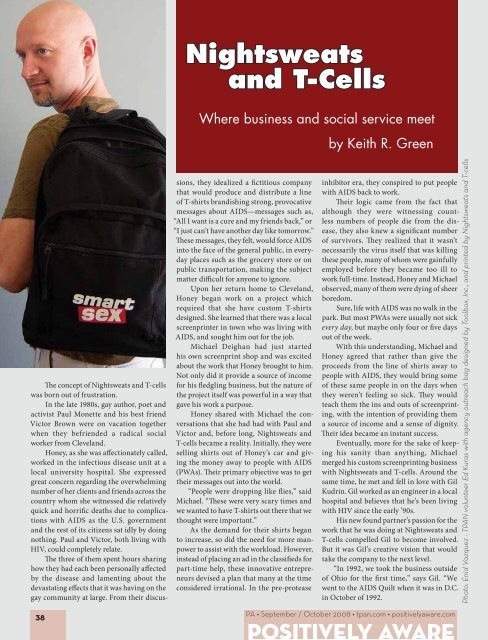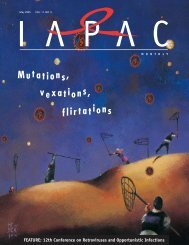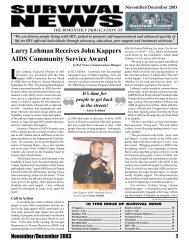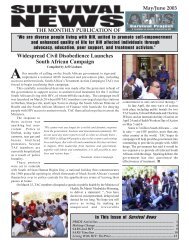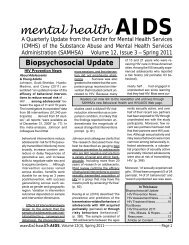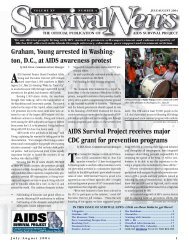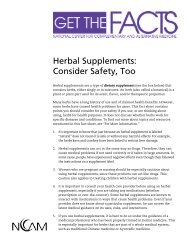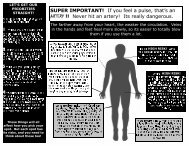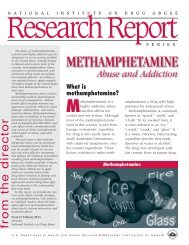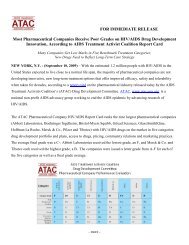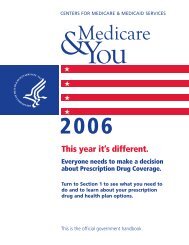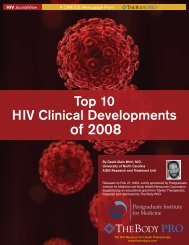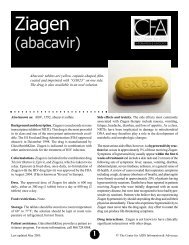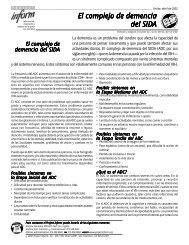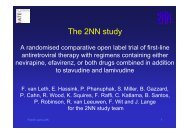WELLNESS STARTS WITH AWARENESS - CD8 T cells - The Body
WELLNESS STARTS WITH AWARENESS - CD8 T cells - The Body
WELLNESS STARTS WITH AWARENESS - CD8 T cells - The Body
You also want an ePaper? Increase the reach of your titles
YUMPU automatically turns print PDFs into web optimized ePapers that Google loves.
Th e concept of Nightsweats and T-<strong>cells</strong><br />
was born out of frustration.<br />
In the late 1980s, gay author, poet and<br />
activist Paul Monette and his best friend<br />
Victor Brown were on vacation together<br />
when they befriended a radical social<br />
worker from Cleveland.<br />
Honey, as she was aff ectionately called,<br />
worked in the infectious disease unit at a<br />
local university hospital. She expressed<br />
great concern regarding the overwhelming<br />
number of her clients and friends across the<br />
country whom she witnessed die relatively<br />
quick and horrifi c deaths due to complications<br />
with AIDS as the U.S. government<br />
and the rest of its citizens sat idly by doing<br />
nothing. Paul and Victor, both living with<br />
HIV, could completely relate.<br />
Th e three of them spent hours sharing<br />
how they had each been personally aff ected<br />
by the disease and lamenting about the<br />
devastating eff ects that it was having on the<br />
gay community at large. From their discus-<br />
38<br />
Nightsweats<br />
and T-Cells<br />
Where business and social service meet<br />
sions, they idealized a fi ctitious company<br />
that would produce and distribute a line<br />
of T-shirts brandishing strong, provocative<br />
messages about AIDS—messages such as,<br />
“All I want is a cure and my friends back,” or<br />
“I just can’t have another day like tomorrow.”<br />
Th ese messages, they felt, would force AIDS<br />
into the face of the general public, in everyday<br />
places such as the grocery store or on<br />
public transportation, making the subject<br />
matter diffi cult for anyone to ignore.<br />
Upon her return home to Cleveland,<br />
Honey began work on a project which<br />
required that she have custom T-shirts<br />
designed. She learned that there was a local<br />
screenprinter in town who was living with<br />
AIDS, and sought him out for the job.<br />
Michael Deighan had just started<br />
his own screenprint shop and was excited<br />
about the work that Honey brought to him.<br />
Not only did it provide a source of income<br />
for his fl edgling business, but the nature of<br />
the project itself was powerful in a way that<br />
gave his work a purpose.<br />
Honey shared with Michael the conversations<br />
that she had had with Paul and<br />
Victor and, before long, Nightsweats and<br />
T-<strong>cells</strong> became a reality. Initially, they were<br />
selling shirts out of Honey’s car and giving<br />
the money away to people with AIDS<br />
(PWAs). Th eir primary objective was to get<br />
their messages out into the world.<br />
“People were dropping like fl ies,” said<br />
Michael. “Th ese were very scary times and<br />
we wanted to have T-shirts out there that we<br />
thought were important.”<br />
As the demand for their shirts began<br />
to increase, so did the need for more manpower<br />
to assist with the workload. However,<br />
instead of placing an ad in the classifi eds for<br />
part-time help, these innovative entrepreneurs<br />
devised a plan that many at the time<br />
considered irrational. In the pre-protease<br />
by Keith R. Green<br />
inhibitor era, they conspired to put people<br />
with AIDS back to work.<br />
Th eir logic came from the fact that<br />
although they were witnessing countless<br />
numbers of people die from the disease,<br />
they also knew a signifi cant number<br />
of survivors. Th ey realized that it wasn’t<br />
necessarily the virus itself that was killing<br />
these people, many of whom were gain fully<br />
employed before they became too ill to<br />
work full-time. Instead, Honey and Michael<br />
observed, many of them were dying of sheer<br />
boredom.<br />
Sure, life with AIDS was no walk in the<br />
park. But most PWAs were usually not sick<br />
every day, but maybe only four or fi ve days<br />
out of the week.<br />
With this understanding, Michael and<br />
Honey agreed that rather than give the<br />
proceeds from the line of shirts away to<br />
people with AIDS, they would bring some<br />
of these same people in on the days when<br />
they weren’t feeling so sick. Th ey would<br />
teach them the ins and outs of screenprinting,<br />
with the intention of providing them<br />
a source of income and a sense of dignity.<br />
Th eir idea became an instant success.<br />
Eventually, more for the sake of keeping<br />
his sanity than anything, Michael<br />
merged his custom screenprinting business<br />
with Nightsweats and T-<strong>cells</strong>. Around the<br />
same time, he met and fell in love with Gil<br />
Kudrin. Gil worked as an engineer in a local<br />
hospital and believes that he’s been living<br />
with HIV since the early ’90s.<br />
His new found partner’s passion for the<br />
work that he was doing at Nightsweats and<br />
T-<strong>cells</strong> compelled Gil to become involved.<br />
But it was Gil’s creative vision that would<br />
take the company to the next level.<br />
“In 1992, we took the business outside<br />
of Ohio for the fi rst time,” says Gil. “We<br />
went to the AIDS Quilt when it was in D.C.<br />
in October of 1992.<br />
PA • September / October 2008 • tpan.com • positivelyaware.com<br />
Positively Aware<br />
Photo: Enid Vazquez - TPAN volunteer Ed Kuras with agency outreach bag designed by Toolbox, Inc., and printed by Nightsweats and T-<strong>cells</strong>


